
If you want to import from China to Pakistan, then you are in the right place. China has the best quality products in all industries. China's imports to Pakistan have many benefits such as high quality products at very low cost, which means high profit margins.
Then this article will take you through the important details of how to import from China to Pakistan, hoping to help you.
Overview |
What Does It Take to Import from China to Pakistan?
There are many benefits of importing from China, including low prices, which means higher profit margins, top quality, diverse products and suppliers, low shipping costs, especially to Pakistan, and innovative products that are different from other countries .
1. Identify your product
To determine the products you wish to import, you must conduct some market research and set import goals. You have to determine whether there is a profitable market for the product you wish to import, conduct competitor analysis, pricing strategy (costs and margins involved), branding and promotion, and distribution channels and logistics for that particular product.
The following are some products suitable for China to import to Pakistan:
- baby clothes
- tools and machinery
- Sports Equipment
- clothing
- toys and games
- Furniture and Footwear
- Plastic, iron and steel products
- Electronics and Motor Vehicles
You also have to decide on product quality, partner relationship management and after-sales service. Therefore, we recommend that you should import a product that you know fits a niche market and can buy in bulk to benefit from economies of scale.
2. Prohibited and restricted items
As an importer, it is your responsibility to ensure that the products you import comply with regulations and laws. The following are some prohibited and restricted items, if you have one of the following items, then you need to delete such items to avoid some troubles.
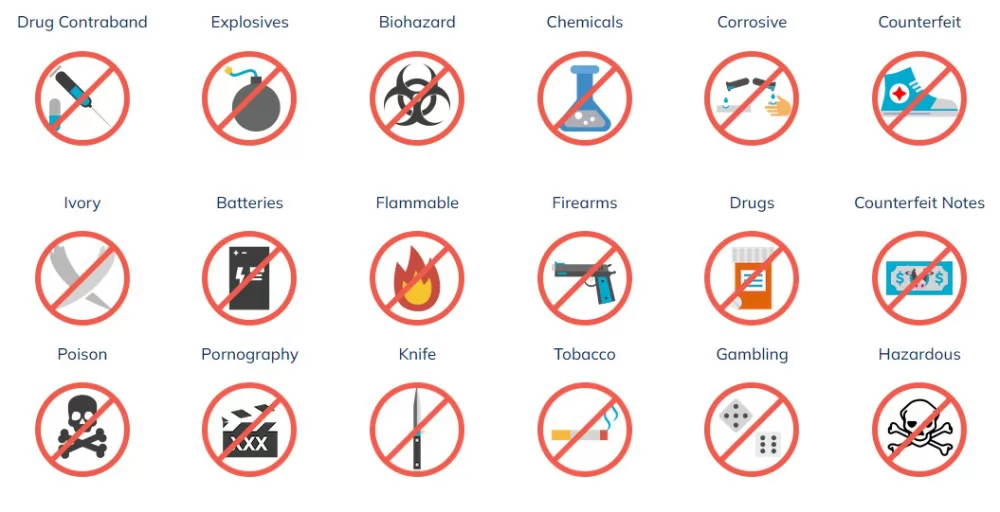
3. Import license required for importing from china to Pakistan
Currently, there is no specific import license requirement for importing from China to Pakistan. Nonetheless, you need to have the following documents in order to successfully import products into Pakistan.
(1) Entity Registration
The first and most important step is to register your business entity. Whether you are a sole proprietorship, a partnership or a private limited company, you will need to register your business with the Pakistani authorities.
So, for example, if you own a private limited company, you need to register with the Securities and Exchange Commission of Pakistan (SECP).
Likewise, as a sole proprietor, you must register your business with the Federal Revenue Board (FBR) of Pakistan to obtain an NTN.
(2) Bank account
You must have a current bank account for documentation and import procedures.
(3) NTN
The National Tax Number (NTN) certificate is one of the most important documents you need to import from China to Pakistan. You can apply for a certificate by visiting the Income Tax Department and a copy of your National Identity Card (NIC) or by applying online.
(4) Business tax registration
Sales Tax Registration Number is another required document that you need from FBR to import products from China to Pakistan.
(5) Chamber of Commerce and Industry (CCI)
Finally, you must obtain a certificate of membership from CCI or any other official trade association in Pakistan.
4. Looking for a purchasing company or pakistani agent in China
It is important to have a sourcing company on board to help you with everything from supplier selection to delivery and customs. The sourcing company will help reduce the risk of importation and avoid any unnecessary costs and delays.
Most importantly, the sourcing company will help you with quoting and costing (landed), placing orders, and communicating with suppliers. You must request a pro forma invoice (must include system number, value of each item, description, dimensions and weight).
At CooloSourcing, we have a special service for Pakistani importers as we have offices in both locations. We can basically be your Pakistani agent in China.
Shipping Methods Imported from China to Pakistan
There are many ways to import from China to Pakistan, and different transportation methods affect the time, cost and safety of transportation. Therefore, choose the appropriate shipping method according to your needs.
1. Shipping by sea
If your supplier is located in a major Chinese port, your goods are larger than 2 cubic meters, and you are in no rush to receive them. Then sea freight is the most suitable choice for you.
The following are three shipping companies that provide port services from China to Pakistan:
-
The port of Karachi is the busiest port in Pakistan. The port handles about 60% of the country's cargo, handling 1.563 million TEUs per year. With eight terminals, the port is one of the largest in South Asia.
-
Port Qassim is the second largest port in the country with an average annual throughput of 681,000 TEUs. It is located on the Arabian Sea. Another important point is that 80% of the automotive industry is located in this port.
-
Gwadar Port started operations in 2016 and actually handles 200,000 deadweight tons (DWT) of ships annually. It is an important part of the China-Pakistan Economic Corridor (CPEC) program and is considered a link between the Belt and Road and Maritime Silk Road projects.
So how long does it take to ship from China to Pakistan?
| Karachi | Qasim | Gwadar | |
|---|---|---|---|
| Tianjin | 22-24 days | 22-24 days | 25-27 days |
| Dalian | 22-23 days | 22-23 days | 23-25 days |
| Shanghai / Ningbo | 21-22 days | 21-22 days | 22-24 days |
| Guangzhou/Hong Kong | 18-19 days | 18-19 days | 19-21 days |
| Qingdao | 22-23 days | 22-23 days | 23-25days |
*Please keep in mind that those transit times are just indicative timing between China and Pakistan
2. Air freight
Unless your goods are less than 2CBM and 200kg or you are urgent to receive the goods, we do not recommend air freight.
Air freight is much more expensive than sea freight. Of course, if you need to receive your goods as soon as possible, air freight is your best choice!
The following is the time required for air transportation from China to Pakistan.
| Jinnah International Airport | Benazir Bhutto International Airport | Allama Iqbal International Airport | |
|---|---|---|---|
| Beijing | 1-3 days | 1-3 days | 1-3 days |
| Shanghai | 1-3 days | 1-3 days | 1-3 days |
| Guangzhou | 1-3 days | 1-3 days | 1-3 days |
*Please also note that shipping times do not include the entire process (pickup and delivery, customs clearance...). On average, you can expect 6/9 days (including export/import process).
There are 139 airports in Pakistan, but only 3 are related to international cargo!
-
Jinnah International Airport is the main airport of Pakistan. Located in Karachi, the airport is the hub of Pakistan International Airlines (PIA). On average, the airport handles more than 120 billion tons of cargo.
-
Allama Iqbal International Airport is the second busiest airport in the country and the third largest civilian airport. It is located in the Punjab province, near Lahore.
-
Benazir Bhutto International Airport is located in the Chaklala district of Rawalpindi. It is the third busiest cargo airport in the country.
3. Rail freight
Pakistan has 11,881 kilometers (7,383 miles) of railways. The China-Pakistan Economic Corridor aims to develop the railway network and increase the efficiency and speed of trains. Phase two of the project is underway and will be completed in 2021. In other words, Pakistan's railway network will be extended to provide an efficient connection with China, which will greatly ease trade between the two countries.
This shipping method should be a very interesting solution for importers/exporters looking to benefit from these infrastructures. In addition, since rail freight is much faster than sea freight, this mode of transportation can be a good alternative to sea and air freight. In fact, rail shipping is cheaper than air shipping.
Pakistan Customs Clearance
Historically, Pakistan was the hub of the ancient Silk Road. Now, with the advancement of the "Belt and Road" and China-Pakistan Economic Corridor projects, these initiatives have opened up new areas of cooperation for both parties.
1. How much duties and taxes to pay?
Calculating tariffs is not a difficult process. All you need is the PCT of the products you are willing to import into Pakistan from China, then go to the Federal Revenue Service's "Tariff Calculator" to find the taxes you have to pay when importing items into Pakistan.
Here is an example.
Suppose you want to import baby clothes from China to Pakistan. Here's what you need to do:
Step 1: Visit the Tariff Calculator website
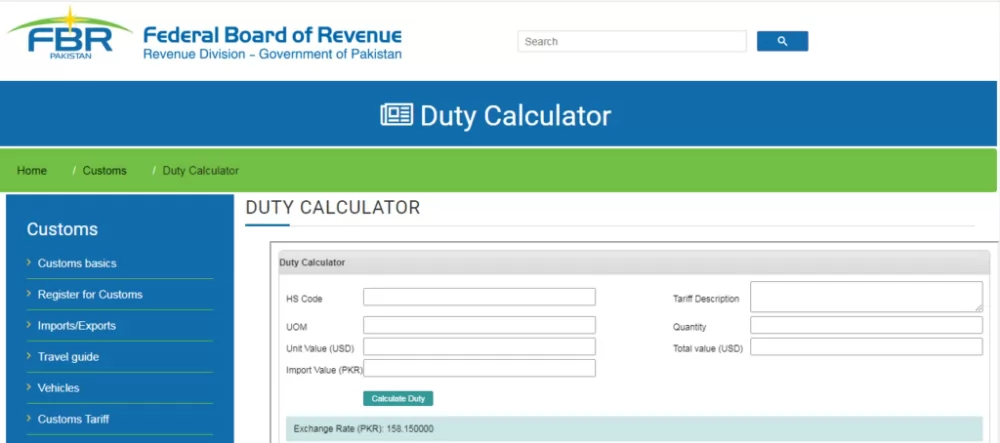
Step 2: Enter the baby clothing PCT in the "HS Code" box.
Once you enter the PCT, you will find the name of the product in the "Tariff Description". In addition, the "UOM" unit is fixed at "Kilogram (KG)" and cannot be changed.
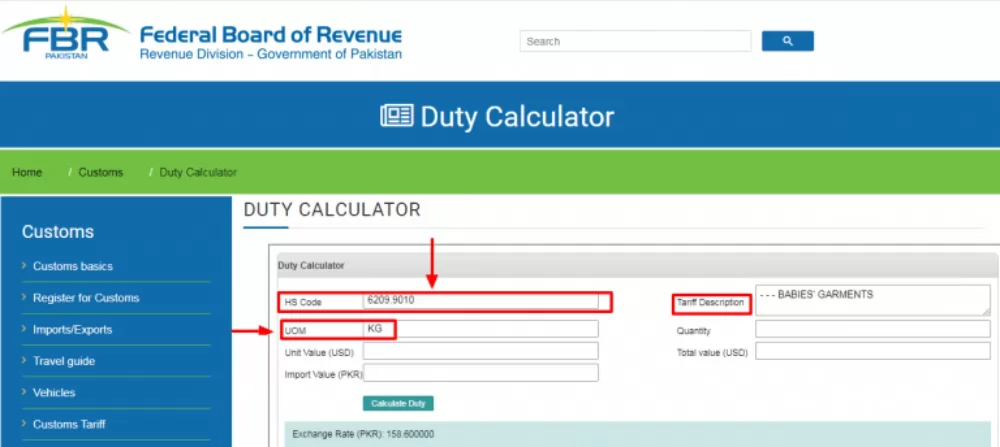
Step 3: Enter the desired product quantity.
For this example, you can see that the value entered is 10. This means that you are willing to import 10 baby clothes.
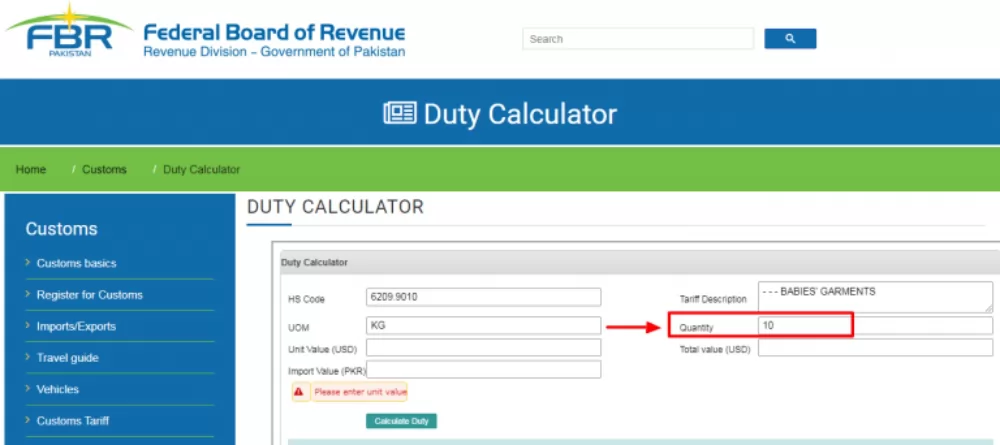
Step 4: Enter the price in USD for each piece/item you are importing.
Suppose the price (unit value) of each item is $3. So as soon as you enter a price, you will see the "Total Value (in USD)" and "Import Value" (in PKR) automatically calculated and displayed.
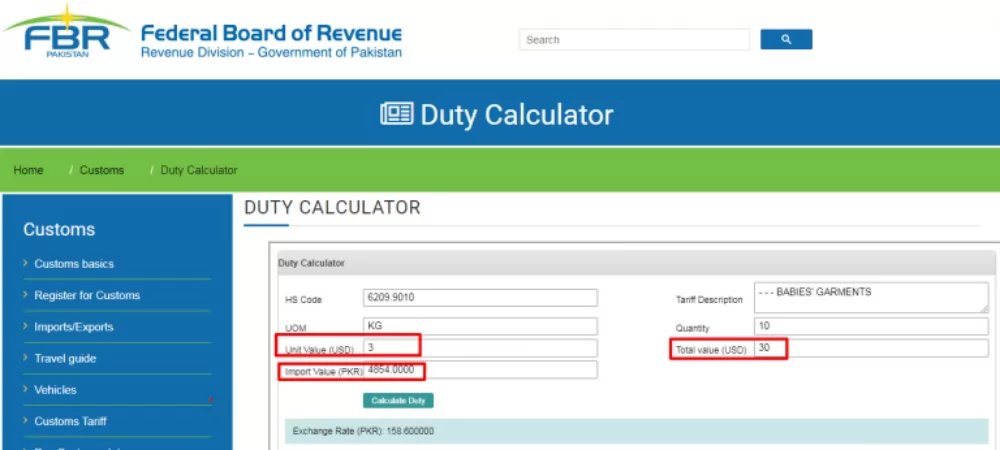
Step 5: Now, click on the "Calculate Tariff" button.
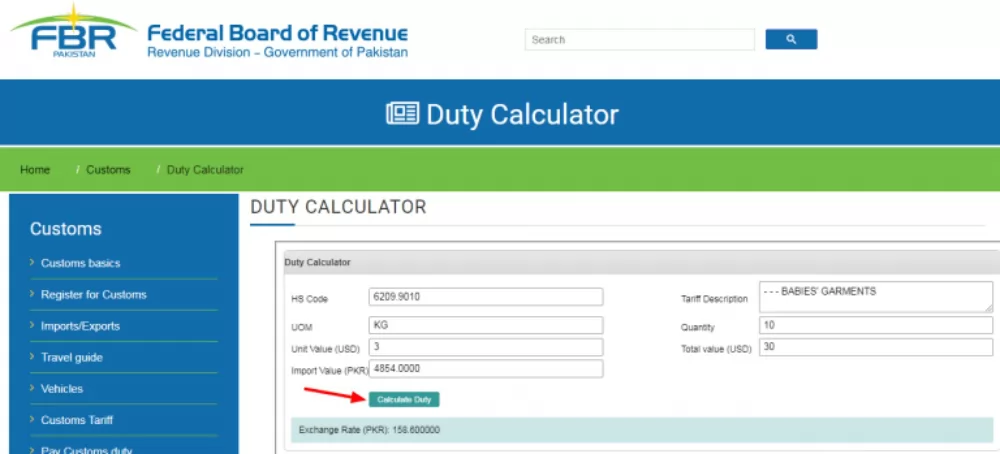
Step 6: A new window will appear showing the "Total" of the tariff.
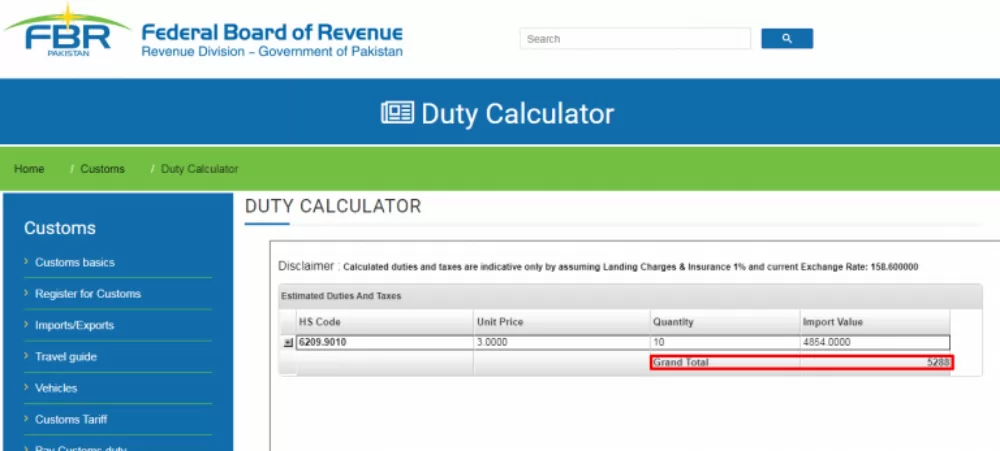
So, click the little "+" button on the left to see the tax details.

You will see the full list of taxes and duties you will have to pay to import 10 baby clothes from China at $3 each, from China to Pakistan.
Apply the same procedure if you want to estimate import duties and all basic taxes for any other item on your list. It is also important to realize that tariffs may change, but no matter what items and units you try to import from China into Pakistan, the sales tax remains the same.
Also, it is always recommended to use an official calculator for accurate values. Reliance on any unauthentic source to calculate tariffs may yield incorrect results. So keep yourself out of trouble.
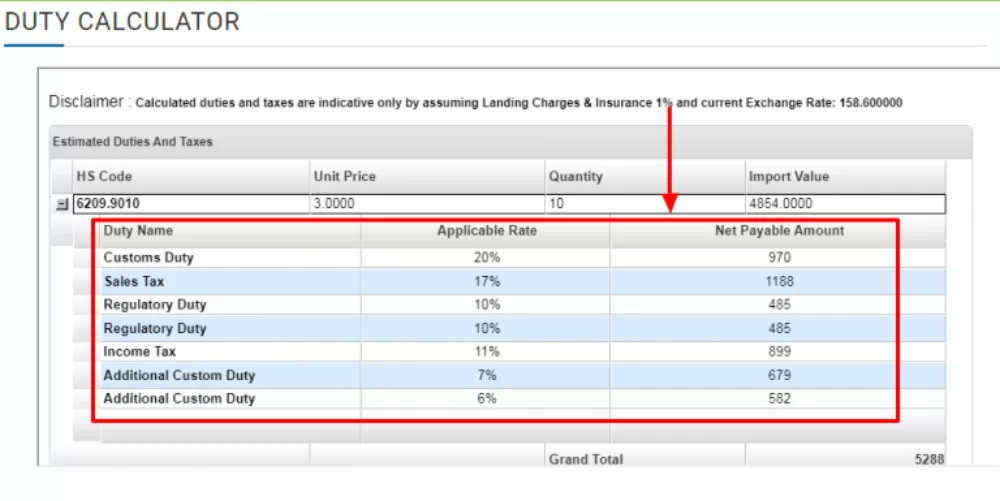
2. There are different taxes on your items
Import duty rates will depend on your product. For some items, such as laptops, importation is free.
Recently, under the China-Pakistan Free Trade Agreement (FTA), Pakistan offered zero tariffs on nearly 6,000 tariff lines from China.
*Keep in mind that tariff structures change frequently.
3. Necessary documents
Bill of Lading or Air Waybill (BL)
The bill of lading (or air waybill) represents the basic contact between the importer and the consignor, authorizes the shipping company to transport the product to the customer's destination, and is also the receipt and proof of ownership for the importer to purchase the product.
Here, we detail how to build BL:
- shipper
- Receiver
- notifying party
- ship number
- loading/discharging port
- Receiving/delivery location
- Container Number
- cargo description
- net weight
- size/volume
Packing List
This document is essential for customs and should detail the HS code (Harmonized System of Tariff Nomenclature)
Certificate of Origin (CO)
This document is an official document given by the government, also known as a product's "birth certificate", showing the product's country of origin.
commercial invoice
The commercial invoice is the actual payment requirement issued by the exporter at the time of the transaction.
certificate of insurance
It is the document that protects imported goods from damage, loss and sometimes delays.
Shipper's import and export declaration
This document refers to the contact information of the exporter and the buyer, which contains the full description, declared value and destination of the product being shipped.
Quality Control When Importing from China to Pakistan
Quality Control (QC) is a process or collection of complex methods to ensure that a created product or service conforms to a given set of quality standards or meets a customer or customer's specifications. Quality leads to competitiveness and is necessary for many product categories. It can earn brand loyalty, which leads to higher profit margins for the business.
1. Know the value of your product
You must know the value of the item. You must know the price range of your product at the stated quality level, and it is understood that different quality products will have different prices.
Once you fully understand your product, target market type, pricing, and other factors, you will be able to determine the quality standards that the products you source must adhere to. Knowing the quality standard of a product is very important as it will play an important role in finding suppliers and communicating with them.
2. Importance of quality suppliers
Regardless of the quality standards you define, suppliers who do not follow good quality control procedures will not be able to produce goods according to the standards you define. Find as much background information as you can from the internet or trade shows.
Once you have identified a group of different suppliers, it is time to order samples to check the quality of the product. These samples should meet your defined quality criteria and whether they effectively deliver the value of the product.
After receiving your sample order, you should determine which supplier is best for you. You must draft quality standards and other key production-related terms in your contracts with suppliers so that these standards are legally binding on suppliers and any breach of such terms can be pursued for any damages.
However, all of these can be performed on your behalf by the purchasing company. Communicate your quality standards to your sourcing companies and use the vast databases of top-notch suppliers these sourcing companies have, who will recommend suitable suppliers for you and ensure quality control of your products. Therefore, the sourcing company becomes a one-stop solution for quality control.
3. Quality control process
The quality control process should be divided into the following three stages or phases.
-
Pre-production: Raw materials are possibly the most important ingredients in any product that is manufactured. Therefore, quality standards should be strictly followed. Suppliers sometimes tend to use the cheapest raw materials to maximize profits, however, the quality of these materials is usually not the best. Therefore, you must take some samples for laboratory testing of these raw materials, as well as check product prototypes and communicate any concerns before mass production.
-
In progress: In-process inspection is another very important stage. Randomly select products from the production line to determine and inspect the quality standards of the products. Make sure the supplier checks that the product is qualified for function, appearance and other key characteristics. Be aware of delivery times though.
-
Before shipment: Make sure the product has been inspected before shipping. A good way to do this is when an order is 100% processed and 80% packed. Suppliers must check for any anomalies or issues and communicate them.
4. Conduct quality control
Quality control can be done by three parties: purchasing agent/company, 3rd party/inspection company and individual. Each of them has its advantages and disadvantages.
(1) purchasing agent
The advantage of purchasing agents for quality control is that they are proficient with local suppliers and can communicate easily, understand quality control due to extensive experience with other customers, cost less than other methods, and can help in other ways. The downside is that they cannot do quality control as effectively as specialized agencies, and quality control varies from agency to agency.
(2) 3rd party
Dedicated control agencies will be able to manage quality very effectively, as their sole purpose is quality, and more experienced and trained inspectors will be strict. The downside is that it costs more and there may be communication barriers that lead to lower quality.
In-person quality control allows you to check so that your product is 100% compliant with your quality standards and nothing goes wrong. The disadvantages are lack of experience, communication barriers, and most importantly, it is the most expensive method.
We recommend that you use a sourcing agent/company or a third party inspection company to conduct quality control on your behalf as they are the most cost effective and can provide other supplier alternatives if the standards do not match.
Conclusion
This article comprehensively analyzes the process and details of importing from China to Pakistan, from determining the products to be imported to what documents need to be prepared, from the mode of transportation to how much tariffs need to be paid.
Here, I would like you to recommend a Chinese sourcing agent, CooloSourcing.
CooloSourcing will make the whole process of importing from China to Pakistan a stress-free and smooth process. We also provide additional services such as pricing and manufacturing negotiations, quality control and shipment management. Our aim is to ensure that our practices and services are fully tailored to your needs. We are not a simple factory sourcing company, but a partner who provides the greatest value to our customers and keeps everything customer-centric!
If you are considering importing from China to Pakistan, then please contact us and we will reply within 24 hours!



